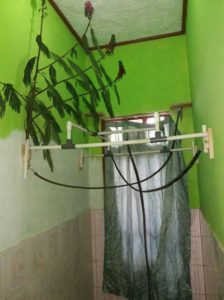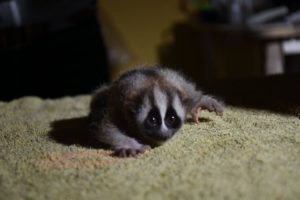Holy Lorises! It has been a very busy 6 weeks at the LFP field station as we’ve seen an enormous increase in the number of lorises brought to us by local residents. The Little Fireface Project is committed to promoting the conservation of all loris species at every level possible. However, our resources in the field are limited and we are not necessarily equipped to be a full-time rescue centre. We are prepared with enough medicine and space to house 1 loris (2 if absolutely necessary) at a time at the field station and often our role is as first responders to loris crises. As a field station we are often “first to the scene” when a slow loris is found or confiscated in our area. When a slow loris is brought to us, our first job is to immediately assess the well-being of that loris. If they are in good physical and mental condition then we try to release them back into the forest as soon as possible, because the less time that any loris spends in captivity, the better (zoos excluded of course). However, oftentimes these lorises have been found either very sick, or have been kept as pets for too long and are in poor health. If we are unable to adequately rehabilitate that loris to a level where they can be re-released, then we immediately send them to our partner organisation: the Cikananga Wildlife Centre for more comprehensive medical care and sometimes permanent residence (in cases where a loris has been too badly injured to be re-released into their natural environment, ie having their teeth pulled out!).

In the world of primate conservation, success rates in rehabilitation and reintroduction programmes are depressing, to say the least. Therefore, it is important to be realistic when dealing with sick and/or potentially injured wildlife. Rehabilitation and release are complex procedures with a great deal of room for error and mishap. Therefore, oftentimes, injured lorises must be sent to rescue centres where their chances at re-introduction are low, for their own well-being. It is a sad reality brought on by habitat degradation and poaching unfortunately.

Therefore, when our first slow loris was brought to the station 6 weeks ago by two young Indonesian men in a backpack, our hopes were, realistic for the future of this loris. However, the loris, an adult female, was in surprisingly good health and after a few days’ observation was able to be released into a good area of our forest! She was so feisty during her time with us at the field station, constantly fighting not only for her food (ripping the heads off of every insect that we gave her in classis slow loris style), but also her very survival; clearly eager to get back to where she belonged. And so we named her Xena and she was released one night into a beautiful patch of forest, ripe with bamboo, Calliandra, and Kayu Putih trees.
Little did we know that that was just the beginning. Over the next 5 weeks, FIVE more lorises were brought into the station! After Xena came two adult males: and Genda. Both were found in nearby villages and brought in separately, again, by chance, both were still in excellent health, clearly not having been out of the wild for too long. Genda and Ajlok were cared for at the field station for just under a week and were released into prime patches of forest. Post-release monitoring showed that they had dispersed in opposite directions and are still in good health!
We next had a surprise when a farmer called our project manager out to his fields one day because he’d found a newborn baby loris on the ground! This slow loris was clearly only weeks old and unable to climb back up to its parents. She was even too weak to hold on to the stalks of a nearby bamboo patch where our team attempted to place her safely. Therefore, another loris was brought back to the station for care. Luckily, she needed only 2 days of feeding and warmth to regain enough strength to be re-introduced and a few nights later our team was able to place her in a bamboo patch near to where she was found. It took only minutes for an adult loris to quickly come, most likely in response to the baby’s calls. It was a heart-warming ending to a possibly fatal situation.

During this time, two lorises were brought in from our current group of observed lorises, after being found in unresponsive states during a nightly observation: Toyib and Dempak. Dempak was unfortunately found on the ground, clearly close to death, and after less than 12 hours of care in the field station he passed away. An autopsy revealed that he had had a serious parasitic infection that had taken over his body. While we mourned this not-so-old lorises’ death, it was a small comfort that we were then able to quickly capture his mate Lucu and their baby and administer pre-emptive anti-parasitic medication. Toyib was found equally unresponsive one week later and swiftly brought back to the station for care. However, only 2 days into antibiotic treatment, he made a miraculous recovery and by the end of his 5-day stay with us he was full of more energy than ever and eager to get back out into the forest! When Toyib was finally brought back to an area of his homerange, he immediately began “running”, making it difficult for our release team to keep up with him. After nearly 45 minutes of navigating some rough terrain at high loris-speeds, the team saw what Toyib had been running to: a very happy and eager mate. Toyib and his mate spent the rest of the night together energetically playing and rolling around together in the trees of their shared homerange.
It just goes to show that happy endings do happen!
- Sharon McCabe
- Field Station Coordinator
